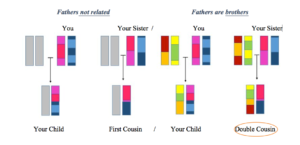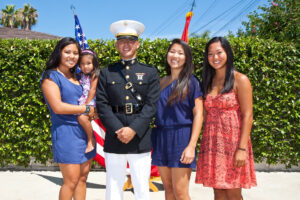Exploring The Relationship With Double Cousins
Many of us can trace the presence of double cousins within our family lineage. In fact, it’s possible that some of our relatives are also our double cousins. Let us discover through this article the precise relationship between double first cousins and explore a family tree illustration.
Meaning of double cousins
What are double cousins? Those who are first cousins via both their paternal and maternal lineages and share both sets of grandparents are known as double first cousins. When two sets of siblings from various families get married, a special relationship is created. When a sister from one family marries a brother from another, for example, and her sister also marries the brother’s sister at the same time, their children are born into two families as first cousins. This happens as a result of the strong genetic ties that bind both sets of parents together.
Understanding Double First Cousins: Genetics and Relationships
Double first cousins are quite unique relationships in families. They have a significant amount of genetic material in them which may be similar to the first cousins. The regular first cousins may share approximately 12.5% of their genetic material in DNA whereas the double first cousins share approximately 25% DNA material and this is quite similar share between half siblings. It is important to know that in spite of highly genetic overlapping, double first cousins cannot be called siblings. Instead their similarity in DNA underscores the unique familial connections within their bloodline. Although if double first cousins undergo a DNA testing procedure they would find a close genetic patch between them. Moreover, the genetic closeness of double first cousins is far more than their immediate relationship. This creates a potential influence on the genetic makeup of upcoming generations.
Double cousins in family tree
In a double cousin relationship, two individuals are connected to each other as cousins through two different ways. This often occurs when two siblings from one family marry two siblings from another family, resulting in their children sharing both sets of grandparents. Here’s a simplified example of a family tree illustrating a double cousin relationship:
Grandparents
/ \
Family A Family B
/ \ / \
Child A1 Child A2 Child B1 Child B2
| | | |
Cousin 1 Cousin 2 Cousin 3 Cousin 4
In this example:
– Grandparents have two sets of siblings: Family A and Family B.
– Child A1 and Child A2 are siblings from Family A, while Child B1 and Child B2 are siblings from Family B.
– Cousin 1 and Cousin 2 are cousins through Family A, sharing grandparents from that side (Child A1 and Child A2’s parents).
– Cousin 3 and Cousin 4 are cousins through Family B, sharing grandparents from that side (Child B1 and Child B2’s parents).
– However, Cousin 1 and Cousin 4 are also cousins through Family B, and Cousin 2 and Cousin 3 are cousins through Family A. This is what makes them double cousins—they share both sets of grandparents. This unique familial arrangement creates a closer genetic relationship between the cousins, akin to being half-siblings genetically rather than just cousins.
Some Data
This picture helped me to understand relationships.
| Relationship | Average DNA shared % |
| identical twin | 100% |
| fraternal twin | 50% |
| parent / child | 50% |
| sibling | 50% |
| half-sibling | 25% |
| grandparent / grandchild | 25% |
| aunt / uncle / niece / nephew | 25% |
| half-aunt / half-uncle / half-niece / half-nephew | 12.5% |
| double-first-cousin | 25% |
| first-cousin | 12.5% |
| half-first-cousin | 6.25% |
| great-grandparent / great-grandchild | 12.5% |
| grandaunt / granduncle / grandniece / grandnephew | 12.5% |
| first-cousin-once-removed | 6.25% |
| second-cousin | 3.125% |
Historical Context of Double Cousin Relationships
In the past, when communities were smaller and travel was limited, marriage options were significantly constrained. Marriages between cousins, even as close as first cousins, were not uncommon. Additionally, it was more likely for multiple children from one family to marry into another, resulting in several couples with siblings from both families. This historical context laid the groundwork for the occurrence of double first cousin relationships.
Acceptance and Norms for Double Cousins
It’s worth noting that there is no inherent taboo or stigma associated with siblings marrying the siblings of an unrelated family. As social dynamics evolve and cultural attitudes shift, the acceptance of diverse familial relationships continues to grow. In essence, the idea of double-cousin relationships remains an original and unique aspect of human connection accepted by them, representing the difficulties and richness of familial bonds across generations over the years.
Potential Challenges of Double Cousin Matches
-
Family History and DNA Research
In the realm of family history research and DNA analysis, double cousin relationships typically pose minimal challenges. Families are generally aware of such connections, making it easier to navigate genealogical inquiries.
-
Misinterpretation of DNA Matches
For individuals unfamiliar with the intricacies of family connections, a double cousin DNA match could be mistaken for that of a half-sibling. This potential misinterpretation may lead to confusion, especially for those outside the immediate family circle.
- Historical Problems with Endogamy
Double cousin marriages within small and insular communities have been a major cause of endogamy in the past. People who marry their first cousins, or any other relative from within their own community for that matter, are practicing endogamy. This usually leads to a collapse in genealogical records known as “pedigree collapse”.
Clarifying the Genetic Relationship Between Double Cousins and Siblings
Double cousins, despite sharing a comparable amount of DNA to half-siblings, do not hold the genetic designation of siblings. The distinction lies in their familial structure: while half-siblings share one common parent, double cousins stem from two separate parental lineages. Thus, although double first cousins share genetic similarities akin to half-siblings, they are not regarded as siblings due to their distinct familial backgrounds. This picture emphasized the subtle genetic relationships within extended families.
Conclusion
As we come to the end of our blog, hope all your queries regarding what are double first cousins are solved now. Now go look at your family tree to find your double first cousins and the genetic relationship in this.
Read More At:
- Nigeria / Africa : DNA, Ancestry, Ethnicity (2024) | Genetics Ancestry
- Norway: DNA, Ancestry, Ethnicity (2024) | Genetics Ancestry
- Paternity DNA Test In Nigeria : Price, Accuracy
- Top 10 DNA Test Kits For Siblings (2024)| Genetics Ancestry
- How to Get a DNA Test While Pregnant At Home? (2024) | Genetics Ancestry
- How To Do A Dna Test At Home With Hair? (2024)



